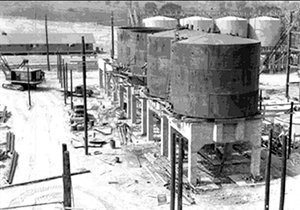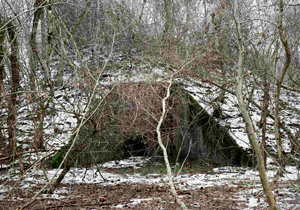The West Virginia Department of Environmental Protection (WVDEP) works in cooperation with the U.S. Environmental Protection Agency (EPA) to oversee and assist the U.S. Department of Defense (DOD) in the investigation and cleanup of active, closing, and formerly used military installations at which hazardous substances and/or petroleum products were used, stored, or disposed of during past operations, as well as military munitions response sites known or suspected to contain unexploded ordnance, discarded military munitions, or munitions constituents.
Overview
In efforts to provide equipped military forces to deter war and to protect the security of the United States, DOD constructed warfare production facilities and military training facilities throughout the country for decades. These facilities were used to store, manufacture, and test materials (including hazardous substances), without the modern and protective environmental practices established today. Operations often resulted in spilling or disposing of hazardous materials onsite or nearby. Furthermore, facilities no longer needed for defense purposes were often abandoned, with buildings, debris, and contamination left behind.
DOD began cleaning up contamination in 1975. In 1986, Congress passed the Defense Environmental Restoration Act and established the Defense Environmental Restoration Program (DERP) to clean up and restore DOD’s contaminated sites. Investigation and remedial actions performed at these sites follow the guidance of the Comprehensive Environmental Response, Compensation, and Liability Act of 1980 (CERCLA), as amended by the Superfund Amendments and Reauthorization Act of 1986 (SARA), and commonly referred to as the Superfund law. The Superfund law imposes requirements on the federal government, including DOD, to identify and address environmental problems for past activities at current and former military installations, even when the release or potential release is not eligible for the National Priorities List (NPL).
Federal Facilities in West Virginia
West Virginia DOD DERP Sites
Federal facilities in West Virginia vary from firing ranges to explosives manufacturing sites. DOD service components with sites in West Virginia include the U.S. Navy, U.S. Army, and U.S. Air Force.
| County |
Installation |
Branch |
Facility Status |
Remediation Status |
| Berkeley |
Shepherd Field Air National Guard Base |
Air Force |
In Use |
Active |
| Grant-Randolph-Tucker |
WV Maneuver Area |
Army |
In Use |
Active |
| Kanawha |
Camp Kanawha |
Army |
Closed |
NFA |
| Kanawha |
Yeager Field Air National Guard Base |
Air Force |
In Use |
Active |
| Mason |
WV Ordinance Works |
Army |
Closed |
Active |
| Mineral |
Allegany Ballistics Lab |
Navy |
In Use |
Active |
| Mineral |
Keyser-Fort Hill Range |
Army |
Closed |
NFA |
| Monongalia |
Ordnance Works Disposal Area |
Army |
Closed |
O&M |
| Preston |
Camp Dawson |
Army |
In Use |
NFA |
| Raleigh |
Beckley Armory Range |
Army |
Closed |
NFA |
| Raleigh |
Sweeneysburg Range |
Army |
Closed |
NFA |
| Raleigh |
Sweeneysburg Range 2 |
Army |
Closed |
NFA |
| Upshur |
Buckhannon Range |
Army |
Closed |
NFA |
| Wood |
Parkersburg Firing Range |
Army |
Closed |
NFA |
| Wood |
Parkersburg Range |
Army |
Closed |
NFA |
Legend:
NFA = No Further Action Required
O&M = Operations and Maintenance
|
Highlighted Sites
West Virginia Maneuver Area
Grant, Randolph, and Tucker Counties
The U.S. Army conducted artillery/mortar practice activities from 1943 to 1944 as training for involvement in World War II. More than 50,000 U.S. troops are estimated to have passed through these 2,180,367 acres of land as they trained for service overseas.
Immediately after the war ended, 189 live mortar shells and 4 live artillery shells were found and destroyed. In the 1980s and 1990s, more sophisticated equipment turned up 57 additional unexploded shells. However, even since then, hikers have found several additional live mortar and artillery rounds. Recreational users in the Dolly Sods Wilderness Area should be aware of the potential presence of Unexploded Ordnance (UXO) and are urged to exercise caution when in the area.
Learn more...

Unexploded Ordnance (UXO) in the Dolly Sods Wilderness Area
West Virginia Ordnance Works
Mason County
The U.S. Army operated West Virginia Ordnance Works (WVOW) from 1942 to 1945 and produced the explosive trinitrotoluene (TNT) for use during World War II. Upon production, the TNT was transported to other government loading plants for insertion into various munitions. When TNT production was suspended at the facility following the end of World War II, the property was transferred from the War Department to War Assets Administration and declared surplus. The facilities were salvaged or disposed after this time.
Contamination at the site was first discovered in 1981, with visible clumps of TNT on the ground surface. The site still has areas that require remediation; however, the majority of the property has been turned into the McClintic Wildlife Management Area, a popular hunting, fishing, and hiking spot managed the West Virginia Division of Natural Resources.
 WVOW Storage Tanks
WVOW Storage Tanks
 WVOW TNT Storage Bunker
WVOW TNT Storage Bunker
State Oversight of Cleanup
Assessment and remediation of DOD sites in West Virginia requires a partnering team process and collaboration between DOD, U.S. EPA, and WVDEP to ensure that sites are in compliance with state and federal environmental policies and regulations.
WVDEP provides oversight and guidance to DOD service component project managers, technical staff, and contractors to ensure that sites are properly prioritized, characterized, and cleaned up to safe levels in accordance with state laws and regulations.
Additional Information
-
Defense Environmental Restoration Program Website
The Office of the Deputy Assistant Secretary of Defense (Environment) (ODASD(Env)) hosted the DERP Forum in St. Louis, Missouri on May 8-9, 2019. The Forum brought DoD and State and Federal regulators together to discuss cleanup issues and strategies at active installations and Base Realignment and Closure locations.